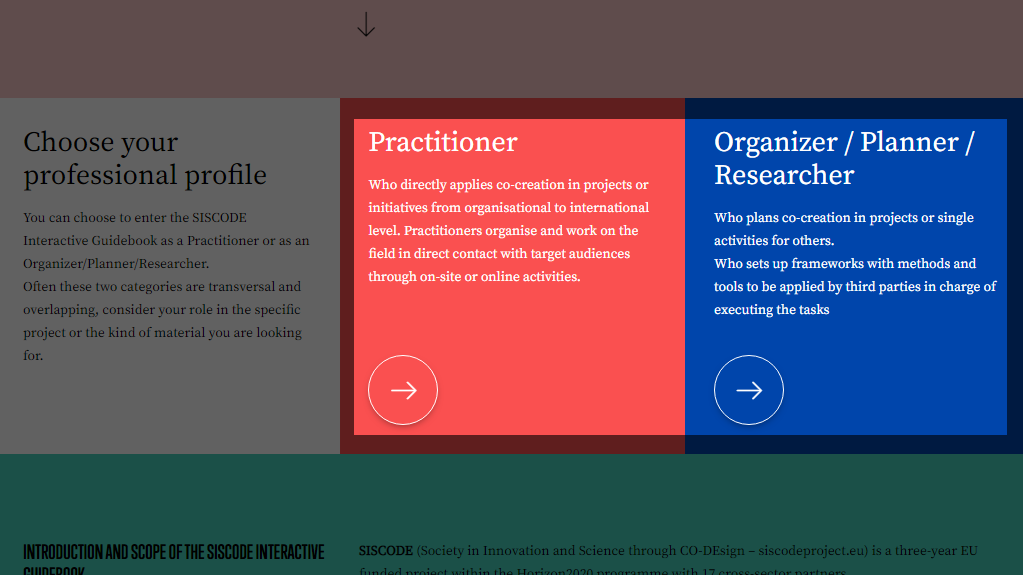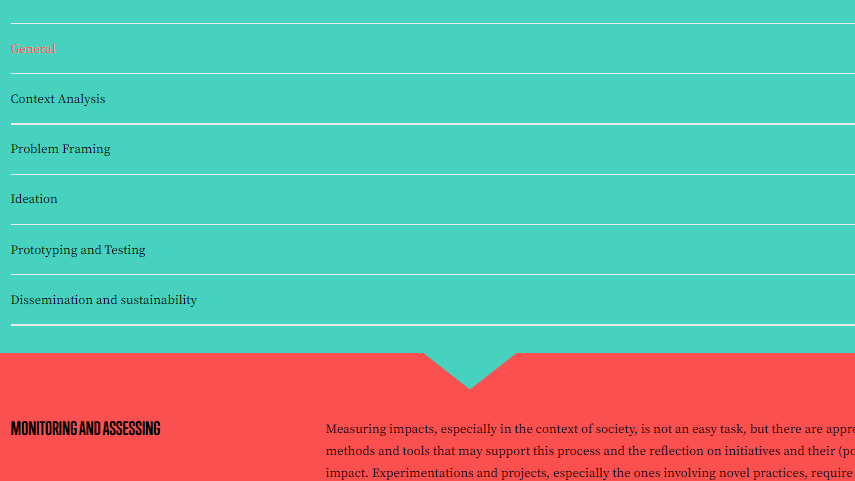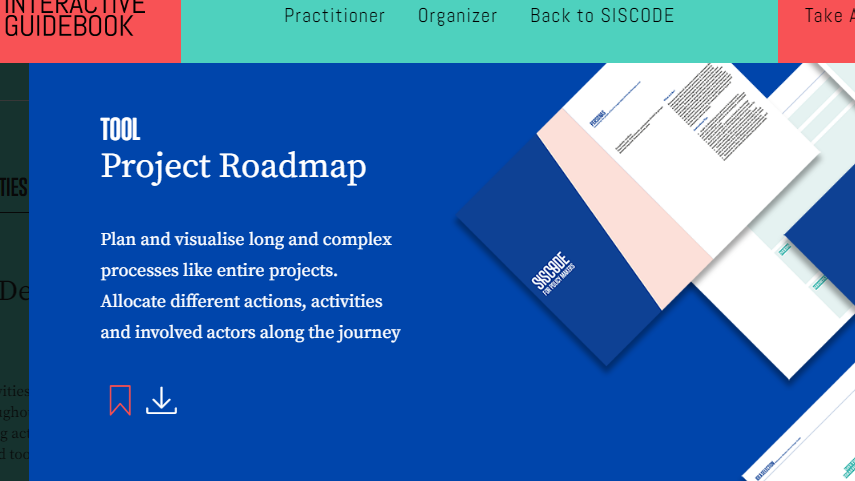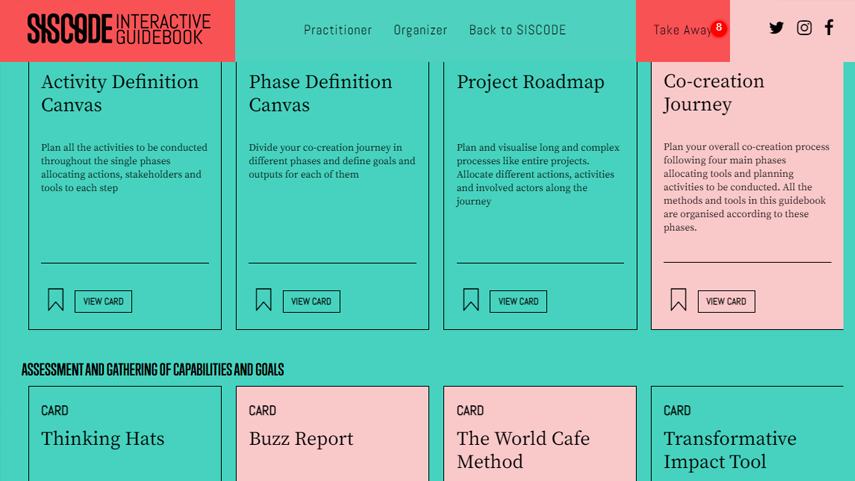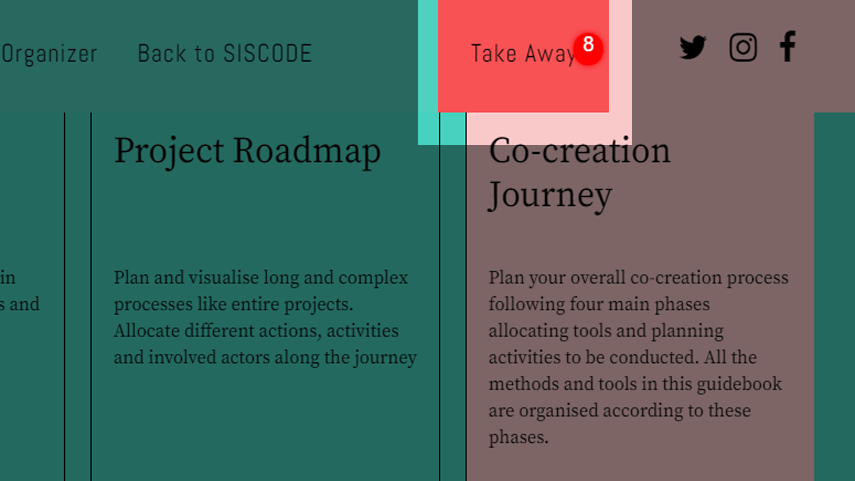PRACTICTIONER
When setting up your co-creation process the SISCODE Interactive Guidebook will support you in engaging users and stakeholders in a learning process themselves by choosing the most suitable ones for the specific project from a variety of possible approaches, methods and tools according to a learning framework divided in different phases.
In SISCODE, we have applied a learning framework based on the experiential learning model by Kolb ( Kolb, D. A. (1983). Experiential Learning: Experience as the Source of Learning and Development. 1 edition. Englewood Cliffs, N.J: Prentice Hall together with classic Design Thinking processes (Dorst, K. (2010). The nature of design thinking. In Design thinking research symposium. DAB Documents).
The SISCODE co-creation framework and its phases

Customisation of methodologies and tools
The high dependency on the specific context and application often requires methods and tools to be adapted for the specific use and project.
The available layouts, descriptions and templates may not precisely fit into all contexts of application, detailed information and practical tips for such customization and adaptation can be found here.
Most of the methodologies and tools gathered in the SISCODE Interactive Guidebook are based on specific templates. Many of them have been developed for specific projects, contexts or initiatives. Therefore, some aspects might not fit your context. For this reason it is paramount to customise and adapt methodologies and tools, according to the specificities of the specific setting where the activity is taking place.
Customizations can be related, but not only, to the following dimensions:
The language of the tool
Hesitation and difficulties in using new and unknown tools can be related to comprehension issues that might be corrected by translating contents into local language to make participants feel for comfortable
Elements or addressed dimensions of a tool
Often, tools have been developed for a specific scope and context and even the same conditions might partially apply to other contexts of application as well. Different elements can be re-defined or described more in detail to fit the specific purpose of application.
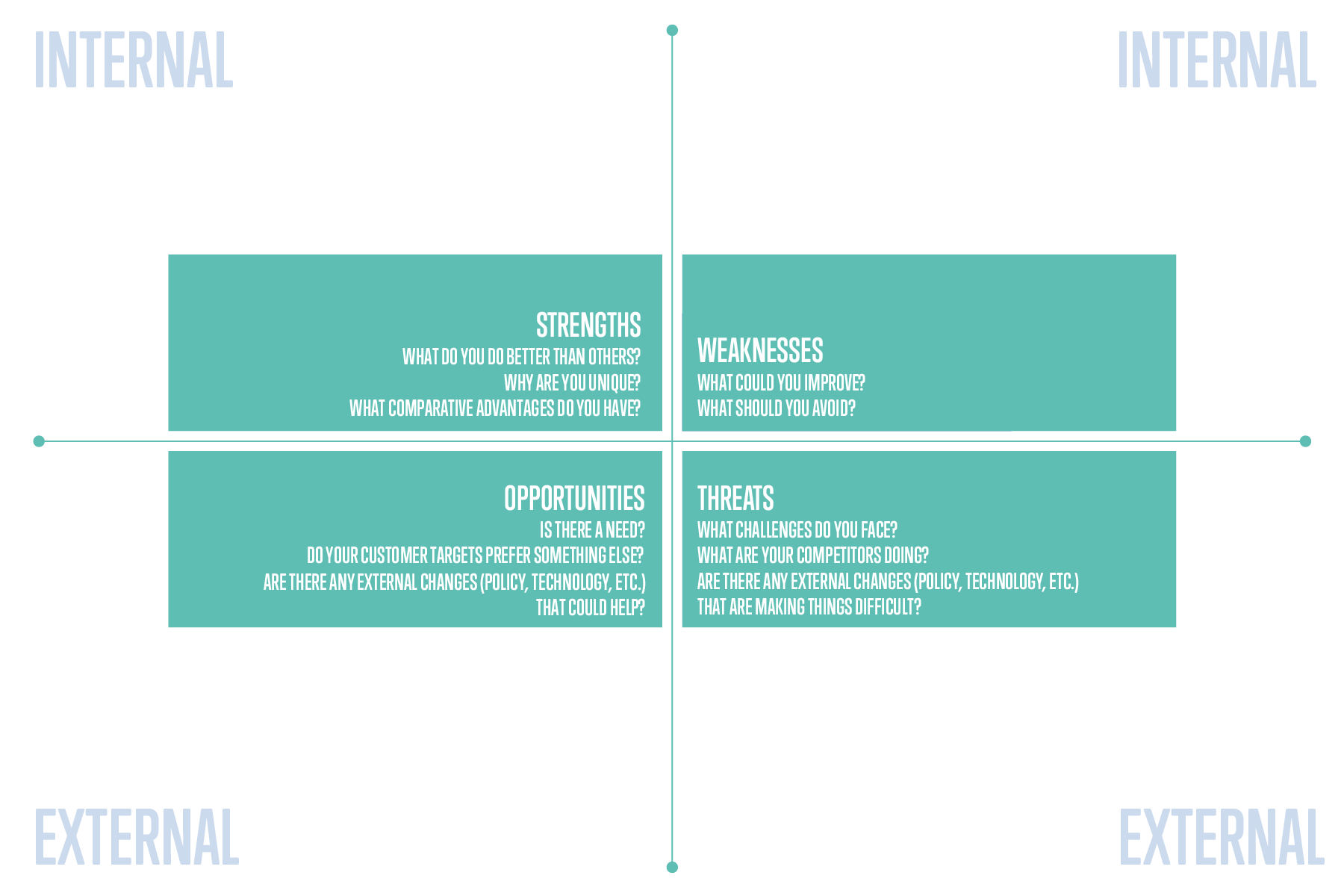
A SWOT analysis adapted for the evaluation of a preliminary concept for a solution – SOURCE
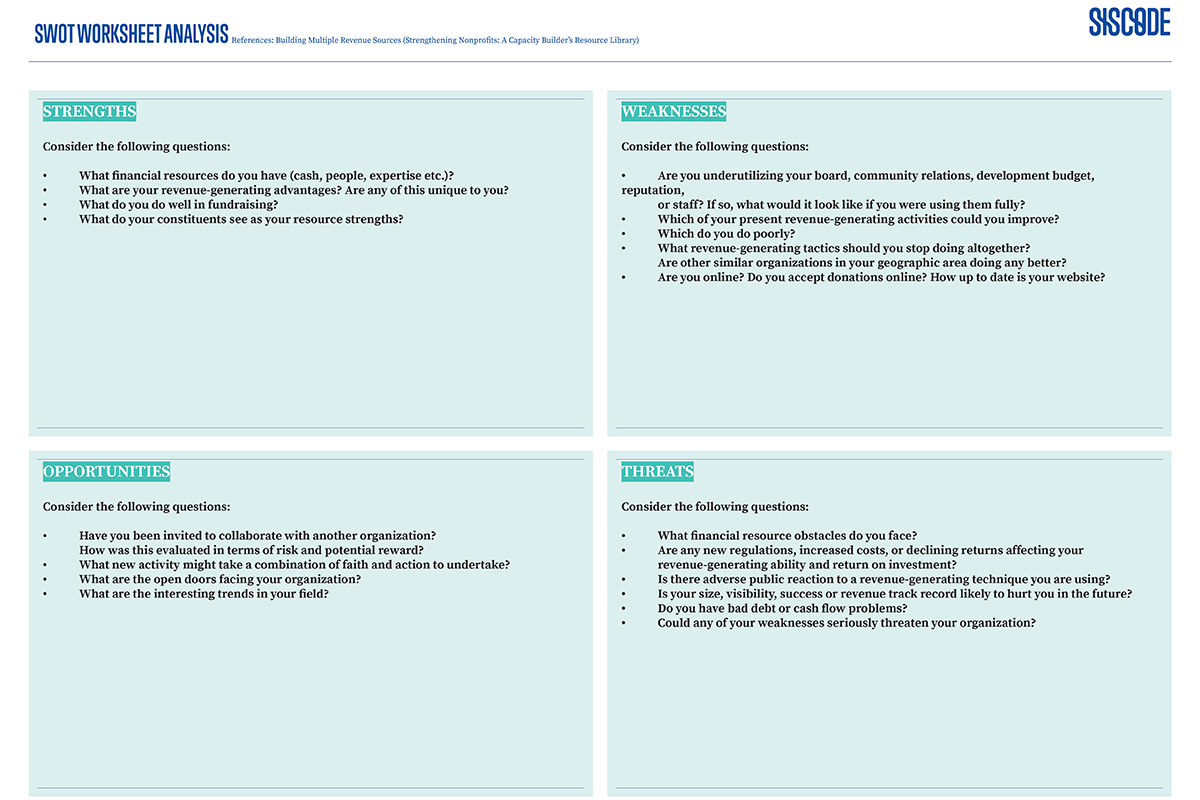
A SWOT analysis adapted to plan the implementation of an advanced solution – SOURCE
Context of use
The direct context of use strongly influences the requirements that a method or tool poses to fit the needs of application. Bigger groups in workshops may require entire tables or walls as a workspace instead of small, printed sheets and tools developed for offline use need to be re-thought defining flexible and static elements when adapting them for online use on collaborative boards. The examples below show a classic stakeholder map template to be printed and used during a physical workshop as well as an adapted version for the collaborative platform Miro.
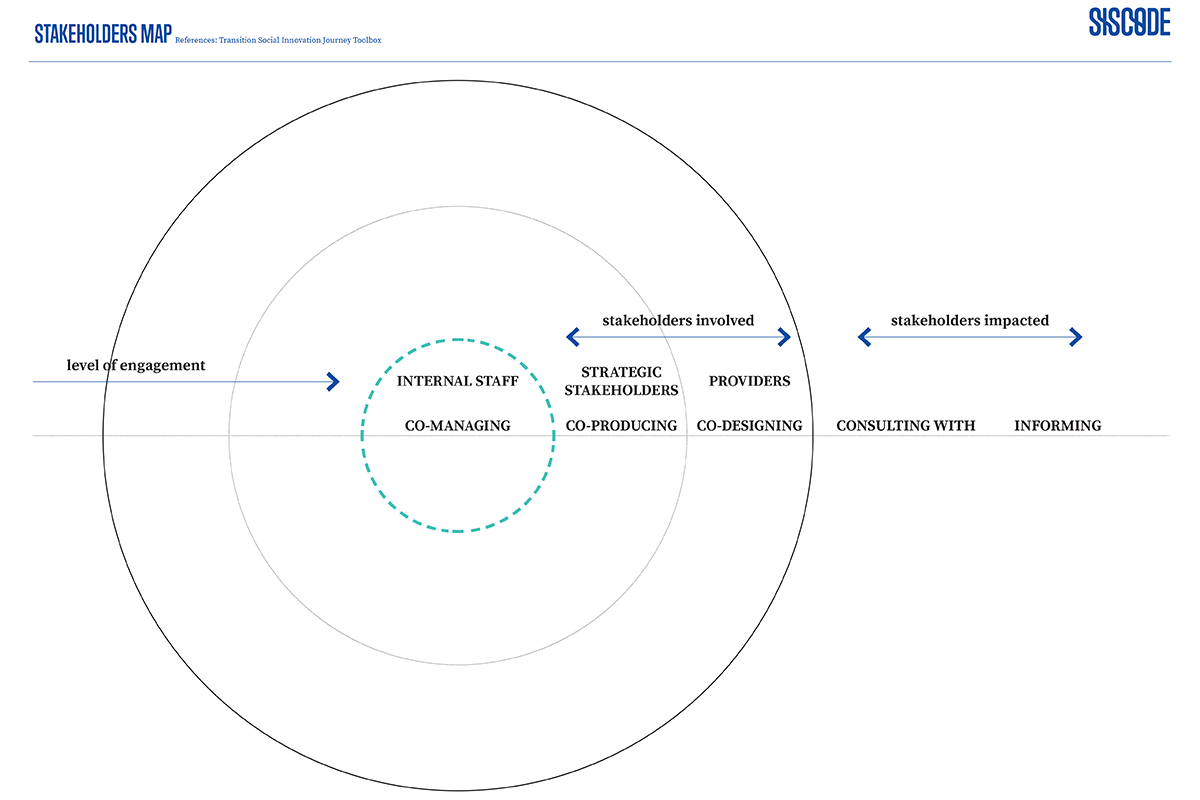
A Stakeholder Map for online use- SOURCE
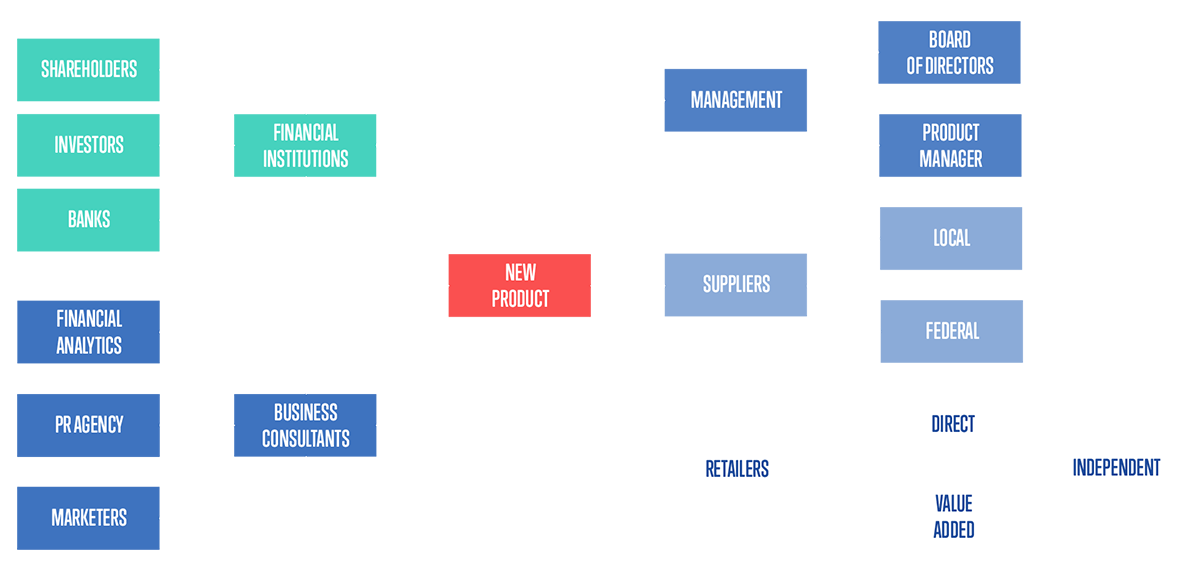
A Stakeholder Map for online use
Source

Designing solutions
“Designing solutions” refers to the overall process of solution development consisting in a set of phases that are:
- General
- Context analysis
- Problem framing
- Ideation
- Prototyping and testing
- Dissemination and sustainability
“Designing solutions” contains methods and tools to plan and set up an overall process of solution development with the application of co-creation. It provides support either in the process of planning before starting an initiative or methods and tools that can be applied throughout all the process in a transversal manner.
Planning of activities
CARD
Activity Definition Canvas
CARD
Phase Definition Canvas
CARD
Project Roadmap
CARD
Co-creation Journey
Assessment and gathering of capabilities and goals
CARD
Thinking Hats
CARD
Buzz Report
CARD
The World Cafe Method
CARD
Transformative Impact Tool
CARD
Who Inspires Us
CARD
Checking the Challenge
CARD
Tips & Tricks for RRI
CARD
Phase Definition Canvas
CARD
Co-creation Journey
Analysis of the environment and the context
CARD
Capital System Methodology
CARD
Logical Framework Matrix
CARD
Skill Share
CARD
Team Canvas
CARD
Lab Capability Canvas
CARD
Phase Definition Canvas
CARD
Co-creation Journey
Analysis and discussion of the overall issue to be addressed
CARD
Stakeholder Map
CARD
(Eco)system Map
CARD
Stakeholder Engagement and Dissemination Plan Canvas
CARD
Stakeholder Visualisation
CARD
Target Group
CARD
Phase Definition Canvas
CARD
Co-creation Journey
Context Analysis
“Context Analysis” is about exploring and mapping the specific context of operation. This phase aims to obtain a complete understanding of the particularities of the context. Particular attention has to be drawn on grasping its culture, the actors and the factors that could influence and even determine the success or failure of solutions developed within and for the context. The context of operation is seen as a complex ecosystem where several factors are interconnected and interrelated.
In this phase, also the social and cultural factors related to the initial challenge are to be carefully analysed.
Analysis of the overall environment
CARD
Challenge Canvas
CARD
SWOT analysis
CARD
Current to New Perspectives
CARD
Expert Workshop
CARD
Buzz Report
Mapping of stakeholders and actors
CARD
Motivation Matrix
CARD
Stakeholder Map
CARD
(Eco)system Map
CARD
Stakeholder Engagement and Dissemination Plan Canvas
Mapping of internal capabilities and skills
CARD
Lab Capability Canvas
Problem Framing
“Problem Framing” the initial problem is to be analysed in depth.
Often an issue is connected and related to other challenges or leads to greater problems as a root cause. The holistic comprehension of the problem is fundamental to properly reframe it, providing understanding for transforming it into an opportunity for the creation of an innovative solution.
Defining and detailing the problem
CARD
Problem sizing canvas
CARD
A Quick Reference Guide for Hosting World Café
CARD
Frameboards
CARD
SWOT analysis
CARD
Buzz Report
Taking new perspectives
CARD
Stakeholder Map
CARD
Stakeholder Engagement and Dissemination Plan Canvas
CARD
Thinking Hats
Connecting the problem to the involved actors
Ideation
During the phase of “Ideation”, new solutions are developed to solve the identified problem.
A large quantity of ideas is to be developed that are then discussed, grouped and eventually combined leading to one single concept of the final solution.
It allows to brainstorm and develop even ideas that are impossible to implement to then combine aspects and ideas to narrow down to a feasible concept that meets the needs of all stakeholders and users.
Generating large amounts of ideas
CARD
Call for ideas
CARD
A Quick Reference Guide for Hosting World Café
Seeing ideas from different views
CARD
Current to New Perspectives
CARD
Thinking Hats
CARD
Who Inspires Us
Evaluating and selecting initial ideas
CARD
The World Cafe Method
CARD
Transformative Impact Tool
Connecting ideas to the context
CARD
Motivation Matrix
Prototyping and Testing
“Prototyping and Testing” entails the transformation of the developed concept into prototypes to be tested with end users and stakeholders.
The testing is fundamental to verify the validity and functionality of a concept. Moreover, it allows the developer of a concept to obtain insight for further improvement, in a period of the design process when changes are still possible, before finally implementing a solution.
Identifying goals for testing
CARD
Prototyping Roadmap
CARD
Customer Journey
CARD
Stakeholder Map
Different types of testing
CARD
Usability Testing
CARD
Logic model
CARD
Thinking Hats
Preparing for the test
CARD
Business Model Canvas
CARD
Storyboard
a sketch, an illustration, a map or any kind of
diagram to make it tangible and tell the story of its functioning
CARD
Transformative Impact Tool
Collecting input for improvement
CARD
Observation
CARD
Transformative Impact Tool
Dissemination and sustainability
“Dissemination and Sustainability” reasons that define which are the expected audiences to reach, and how to reach them in order to share research results. Expected audiences for dissemination are potential users and peers in the research field, industry and commercial players,policymakers, or potential investors. Disseminating the research results with the scientific community of reference is crucial for contributing to the progress of science.
In parallel, developing a sustainability plan means envisioning sustainable trajectories for the solutions under development. This is in terms of sustainability towards the market where the solution is situated, especially in the long-term, and in terms of application, replication and even scaling, considering both economic and social impact.
Strategies for dissemination
CARD
Prototyping Roadmap
CARD
Stakeholder Map
CARD
Target Group
Preparation for funding opportunities
CARD
Roadmap to sustainability
CARD
Pitch deck
CARD
Business Plan Summary
CARD
Business Plan
CARD
Usability Testing
CARD
Thinking Hats
Choice for funding opportunities
CARD
Pugh chart
CARD
Business Model Canvas
CARD
Storyboard
a sketch, an illustration, a map or any kind of
diagram to make it tangible and tell the story of its functioning
Monitoring and Assessing
Measuring impacts, especially in the context of society, is not an easy task, but there are approaches, methods and tools that may support this process and the reflection on initiatives and their (potential) impact. Experimentations and projects, especially the ones involving novel practices, require assessment activities in order to determine not only their success or failure, but also to identify a potential for replication, best practices and obstacles to be tackled in the future. They play a key role for long-term sustainability.
The methods and tools collected in the “Monitoring and assessment” section can be employed for the assessment of single element like prototypes as well as for the evaluation of an entire development process and its efficacy. It may also support the understanding to what extent the solution developed has the potential to impact the current economic, social or environmental context.
Planning of monitoring & assessment activities
CARD
Assessment Roadmap
CARD
Prototyping Roadmap
CARD
Stakeholder Map
CARD
Activity Definition Canvas
Defining indicators and influencing factors
CARD
Pitch deck
CARD
Business Plan Summary
CARD
Usability Testing
CARD
Logic model
CARD
Logical Framework Matrix
CARD
Thinking Hats
CARD
Transformative Impact Tool
Defining and planning of evaluation activities
CARD
Assessment Roadmap
CARD
Pugh chart
CARD
Logic model
CARD
Prototyping Roadmap
CARD
Stakeholder Map
CARD
Transformative Impact Tool
CARD
Activity Definition Canvas
Tools for monitoring and evaluation
CARD
Feedback Wall
CARD
Card sorting
CARD
Focus Group
CARD
Business Plan Summary
CARD
Observation
CARD
Logic model
Assessment of organisational capacities
CARD
Assessment Roadmap
CARD
Pugh chart
CARD
Logic model
CARD
Prototyping Roadmap
CARD
Stakeholder Map
CARD
Transformative Impact Tool
CARD
Activity Definition Canvas
Impact assessment
CARD
Feedback Wall
CARD
Card sorting
CARD
Focus Group
CARD
Business Plan Summary
CARD
Observation
CARD
Logic model
Assessment of RRI dimensions
CARD
Societal Readiness Thinking Tool
CARD
Card sorting
CARD
Focus Group
CARD
Observation
CARD
Transformative Impact Tool
CARD


